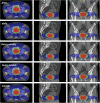Dosimetric Impact of the Positional Imaging Frequency for Hypofractionated Prostate Radiotherapy - A Voxel-by-Voxel Analysis
- PMID: 33134166
- PMCID: PMC7550661
- DOI: 10.3389/fonc.2020.564068
Dosimetric Impact of the Positional Imaging Frequency for Hypofractionated Prostate Radiotherapy - A Voxel-by-Voxel Analysis
Abstract
Background: To investigate deviations between planned and applied treatment doses for hypofractionated prostate radiotherapy and to quantify dosimetric accuracy in dependence of the image guidance frequency.
Methods: Daily diagnostic in-room CTs were carried out in 10 patients in treatment position as image guidance for hypofractionated prostate radiotherapy. Fraction doses were mapped to the planning CTs and recalculated, and applied doses were accumulated voxel-wise using deformable registration. Non-daily imaging schedules were simulated by deriving position correction vectors from individual scans and used to rigidly register the following scans until the next repositioning before dose recalculation and accumulation. Planned and applied doses were compared regarding dose-volume indices and TCP and NTCP values in dependence of the imaging and repositioning frequency.
Results: Daily image-guided repositioning was associated with only negligible deviations of analyzed dose-volume parameters and conformity/homogeneity indices for the prostate, bladder and rectum. Average CTV T did not significantly deviate from the plan values, and rectum NTCPs were highly comparable, while bladder NTCPs were reduced. For non-daily image-guided repositioning, there were significant deviations in the high-dose range from the planned values. Similarly, CTV dose conformity and homogeneity were reduced. While TCPs and rectal NTCPs did not significantly deteriorate for non-daily repositioning, bladder NTCPs appeared falsely diminished in dependence of the imaging frequency.
Conclusion: Using voxel-by-voxel dose accumulation, we showed for the first time that daily image-guided repositioning resulted in only negligible dosimetric deviations for hypofractionated prostate radiotherapy. Regarding dosimetric aberrations for non-daily imaging, daily imaging is required to adequately deliver treatment.
Keywords: dosimetry; hypofractionation; image-guided radiotherapy; organs-at-risk; prostate cancer; tumor control probability.
Copyright © 2020 Splinter, Sachpazidis, Bostel, Fechter, Zamboglou, Thieke, Jäkel, Huber, Debus, Baltas and Nicolay.
Figures





Similar articles
-
Dosimetric Impact of Interfractional Variations in Prostate Cancer Radiotherapy-Implications for Imaging Frequency and Treatment Adaptation.Front Oncol. 2019 Sep 27;9:940. doi: 10.3389/fonc.2019.00940. eCollection 2019. Front Oncol. 2019. PMID: 31612106 Free PMC article.
-
Dosimetric Impact of Interfractional Variations for Post-prostatectomy Radiotherapy to the Prostatic Fossa-Relevance for the Frequency of Position Verification Imaging and Treatment Adaptation.Front Oncol. 2019 Nov 8;9:1191. doi: 10.3389/fonc.2019.01191. eCollection 2019. Front Oncol. 2019. PMID: 31788450 Free PMC article.
-
Dosimetric and radiobiological consequences of computed tomography-guided adaptive strategies for intensity modulated radiation therapy of the prostate.Int J Radiat Oncol Biol Phys. 2013 Dec 1;87(5):874-80. doi: 10.1016/j.ijrobp.2013.07.006. Epub 2013 Aug 24. Int J Radiat Oncol Biol Phys. 2013. PMID: 23978708
-
Assessment and management of interfractional variations in daily diagnostic-quality-CT guided prostate-bed irradiation after prostatectomy.Med Phys. 2014 Mar;41(3):031710. doi: 10.1118/1.4866222. Med Phys. 2014. PMID: 24593714
-
Image-guided adaptive radiation therapy (IGART): Radiobiological and dose escalation considerations for localized carcinoma of the prostate.Med Phys. 2005 Jul;32(7Part1):2193-2203. doi: 10.1118/1.1935775. Med Phys. 2005. PMID: 28493587
Cited by
-
Image-guided radiation therapy (IGRT) in prostate cancer in México, survey of SOMERA (Sociedad Mexicana de Radioterapeutas/Mexican Society of Radiation Oncologists) with recommendations on its implementation and process.Rep Pract Oncol Radiother. 2023 Jun 26;28(2):198-206. doi: 10.5603/RPOR.a2023.0023. eCollection 2023. Rep Pract Oncol Radiother. 2023. PMID: 37456698 Free PMC article.
-
Advantages and robustness of partial VMAT with prone position for neoadjuvant rectal cancer evaluated by CBCT-based offline adaptive radiotherapy.Radiat Oncol. 2023 Jun 17;18(1):102. doi: 10.1186/s13014-023-02285-6. Radiat Oncol. 2023. PMID: 37330508 Free PMC article.
-
Cone beam CT-based dose accumulation and analysis of delivered dose to the dominant intraprostatic lesion in primary radiotherapy of prostate cancer.Radiat Oncol. 2021 Oct 26;16(1):205. doi: 10.1186/s13014-021-01933-z. Radiat Oncol. 2021. PMID: 34702305 Free PMC article.
References
-
- Kupelian PA, Potters L, Khuntia D, Ciezki JP, Reddy CA, Reuther AM, et al. Radical prostatectomy, external beam radiotherapy or =72 Gy, permanent seed implantation, or combined seeds/external beam radiotherapy for stage T1-T2 prostate cancer. Int J Radiat Oncol Biol Phys. (2004) 58:25–33. 10.1016/S0360-3016(03)00784-3 - DOI - PubMed
-
- Viani GA, Viana BS, Martin JE, Rossi BT, Zuliani G, Stefano EJ. Intensity-modulated radiotherapy reduces toxicity with similar biochemical control compared with 3-dimensional conformal radiotherapy for prostate cancer: a randomized clinical trial. Cancer. (2016) 122:2004–11. 10.1002/cncr.29983 - DOI - PubMed
LinkOut - more resources
Full Text Sources
Research Materials

